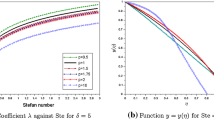Abstract
The Stefan problem involving a source term is considered in this technical note. As an example, planar solidification with time-dependent heat generation in a semi-infinite plane is solved by use of a perturbation technique. The perturbation solution is validated by reducing the problem to the case without heat generation whose exact solution is available. An application to the case with constant heat generation is presented, for which a closed-form solution is obtained. The effects of heat generation and Stefan number on the evolution of solidification are examined using the perturbation solution.



Similar content being viewed by others
Abbreviations
- A, B:
- a, b, c:
-
Coefficients, defined by Eq. 29
- c p :
-
Specific heat (J/kg K)
- k :
-
Thermal conductivity (W/m K)
- L :
-
Latent heat of fusion (J/kg)
- l :
-
Characteristic length (m)
- q′″:
-
Volumetric heat generation (W/m3)
- Ste:
-
Stefan number, defined in Eq. 5
- s :
-
Interface location (m)
- T :
-
Temperature (K)
- t :
-
Time (s)
- x :
-
Coordinate (m)
- α :
-
Thermal diffusivity (W/m2)
- δ :
-
Dimensionless heat generation
- ε :
-
Perturbation parameter
- θ :
-
Dimensionless temperature
- λ :
-
Dimensionless interface location
- ξ :
-
Dimensionless coordinate
- ρ :
-
Density (kg/m3)
- τ :
-
Dimensionless time
- b :
-
At the boundary
- f :
-
Freezing
- 0, 1:
-
Coefficients associated with power 0 and 1
References
Özişik MN (1980) Heat conduction. Wiley, New York
Jiji LM (2009) Heat conduction, 3rd edn. Springer, Berlin
Muehlbauer JC, Sunderland JE (1965) Heat conduction with freezing or melting. Appl Mech Rev 18:951–959
Gupta SC (2003) The classical Stefan problem. Elsevier, Amsterdam
Lock GSH (1971) On the perturbation solutions of the ice-water layer problem. Int J Heat Mass Transf 14:642–644
Pedroso RI, Domoto GA (1973) Exact solution by perturbation method for planar solidification of a saturated liquid with convection at the wall. Int J Heat Mass Transf 16:1816–1819
Huang C-L, Shih Y-P (1975) Perturbation solutions of planar diffusion-controlled moving-boundary problems. Int J Heat Mass Transf 18:689–695
Huang C-L, Shih Y-P (1975) Perturbation solution for planar solidification of a saturated liquid with convection at the wall. Int J Heat Mass Transf 18:1481–1483
Pedroso RI, Domoto GA (1973) Perturbation solutions for spherical solidification of saturated liquids. J Heat Transf 95:42–46
Huang C-L, Shih Y-P (1975) A perturbation method for spherical and cylindrical solidification. Chem Eng Sci 30:897–906
Aziz A, Na TY (1984) Perturbation methods in heat transfer. Hemisphere Publishing Corporation, Washington, DC
Lunardini VJ, Aziz A (1993) Perturbation techniques in conduction-controlled freeze–thaw heat transfer. Monograph 93-1, Cold Regions Research & Engineering Laboratory, US Army Corps of Engineers
Caldwell J, Kwan YY (2003) On the perturbation method for the Stefan problem with time-dependent boundary conditions. Int J Heat Mass Transf 46:1497–1501
Basak T (2003) Analysis of resonances during microwave thawing of slabs. Int J Heat Mass Transf 46:4279–4301
Rattanadecho P (2004) Theoretical and experimental investigation of microwave thawing of frozen layer using a mircowave oven (effects of layered configurations and layer thickness). Int J Heat Mass Transf 47:937–945
Li JF, Li L, Stott FH (2004) Comparison of volumetric and surface heating sources in the modeling of laser melting of ceramic materials. Int J Heat Mass Transf 47:1159–1174
Cheung FB, Chawla TC, Pedersen DR (1984) The effects of heat generation and wall interaction on freezing and melting in a finite slab. Int J Heat Mass Transf 27:29–37
Jiji LM, Gaye S (2006) Analysis of solidification and melting of PCM with energy generation. Appl Therm Eng 26:568–575
Crepeau J, Siahpush A (2008) Approximate solutions to the Stefan problem with internal heat generation. Heat Mass Transf 44:787–794
Crepeau JC, Siahpush A, Spotten B (2009) On the Stefan problem with volumetric energy generation. Heat Mass Transf 46:119–128
Acknowledgments
The financial support from the National Natural Science Foundation of China (NSFC) under Grant No. 50706044 is gratefully acknowledged. Z.-T. Yu wishes to appreciate a grant from the Program of Zhejiang University for Outstanding Young Faculty Members (Zi-Jin Program).
Author information
Authors and Affiliations
Corresponding author
Rights and permissions
About this article
Cite this article
Yu, ZT., Fan, LW., Hu, YC. et al. Perturbation solution to heat conduction in melting or solidification with heat generation. Heat Mass Transfer 46, 479–483 (2010). https://doi.org/10.1007/s00231-010-0596-4
Received:
Accepted:
Published:
Issue Date:
DOI: https://doi.org/10.1007/s00231-010-0596-4




